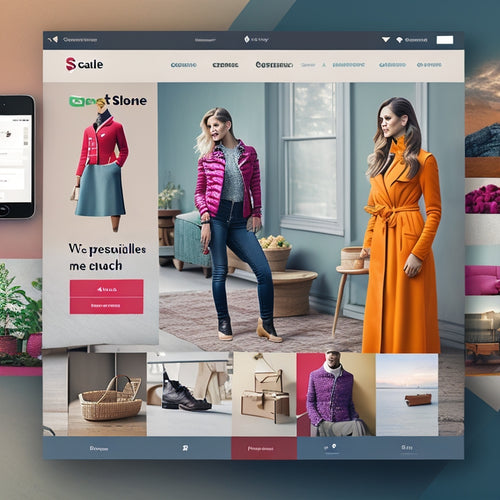
Revolutionizing Ecommerce: Future Trends in Automation
Share
Ecommerce automation is transforming the industry, driven by projected sales of $6.5 trillion by 2023. By leveraging data-driven insights, AI-driven optimization, and personalized marketing strategies, businesses can enhance customer experience, drive revenue growth, and gain a competitive edge. Automation optimizes the customer journey, identifies pain points, and fosters customer loyalty. AI-driven personalization increases conversion rates, while virtual reality experiences and advanced data analytics guarantee precise customer segmentation. To stay ahead, businesses must adopt future-focused automation strategies that integrate omnichannel messaging, automated workflows, and A/B testing to maximize ROI. As the ecommerce landscape continues to evolve, the most innovative strategies will emerge.
Key Takeaways
• Ecommerce automation optimizes customer journeys, driving revenue growth through tailored marketing strategies and improved operational efficiency.
• AI-driven personalization increases conversion rates, with virtual reality experiences enhancing customer engagement and advanced data analytics ensuring precise segmentation.
• AI-driven strategies can increase average order value by 15%, while predictive analytics lead to a 25% rise in conversions and dynamic content improves customer satisfaction by 20%.
• Data-driven approaches using AI-driven optimization, customer journey mapping, and omnichannel integration will revolutionize ecommerce automation.
• Automated workflows and A/B testing will reduce manual errors, increase efficiency, and optimize marketing campaigns, leading to improved ROI.
Ecommerce Automation Essentials
As ecommerce continues to evolve at an unprecedented rate, with online sales projected to reach $6.5 trillion by 2023, it is essential for businesses to grasp the fundamental principles of ecommerce automation to stay competitive and drive growth.
Ecommerce automation is vital for optimizing the customer journey, ensuring seamless engagement across touchpoints. By leveraging data-driven insights, businesses can identify pain points and opportunities to enhance the customer experience.
Automation enables the creation of tailored marketing strategies, personalized recommendations, and targeted campaigns, ultimately influencing buying decisions and driving revenue growth. By embracing ecommerce automation, businesses can stay ahead of the curve, improve operational efficiency, and foster long-term customer loyalty.
Future of Personalized Marketing
Ecommerce businesses that prioritize personalized marketing are positioned to gain significant rewards, as advancements in AI, machine learning, and data analytics enable the realization of highly targeted and relevant customer experiences.
-
AI-driven personalization allows for tailored product recommendations, increasing conversion rates and customer satisfaction.
-
Virtual reality experiences revolutionize customer engagement, providing immersive and interactive interactions with products.
-
Advanced data analytics enables precise customer segmentation, ensuring targeted marketing campaigns reach the intended audience.
-
Real-time personalization adapts to customer behavior, delivering dynamic content and offers that resonate with individual preferences.
-
Predictive analytics forecasts customer needs, enabling proactive marketing strategies that drive loyalty and retention.
Maximizing Revenue With Tech
Leveraging cutting-edge technologies, such as artificial intelligence and machine learning, enables ecommerce businesses to maximize revenue by creating seamless, omnichannel experiences that resonate with customers and drive conversions.
| AI Driven Strategies | Revenue Impact | Customer Experience |
|---|---|---|
| Personalized product recommendations | 15% increase in AOV | Tailored suggestions based on customer behavior |
| Virtual reality experiences | 30% boost in engagement | Immersive and interactive brand interactions |
| Predictive analytics for targeted marketing | 25% rise in conversions | Relevant and timely offers |
| Dynamic content for omnichannel messaging | 20% improvement in customer satisfaction | Consistent and cohesive brand voice |
Automation Strategies for Growth
By integrating automation strategies into their operations, businesses can potentially access up to 30% more revenue, while also streamlining processes and enhancing the overall customer experience.
To achieve this, companies must adopt a data-driven approach, leveraging AI-driven optimization to inform their decision-making. Customer journey mapping is also essential, allowing businesses to identify pain points and areas for improvement.
Additionally, omnichannel integration guarantees a seamless customer experience across all touchpoints.
-
Implementing automated workflows to reduce manual errors and increase efficiency
-
Utilizing customer data to create personalized experiences and improve loyalty
-
Conducting A/B testing to optimize marketing campaigns and improve ROI
-
Developing predictive analytics to forecast customer behavior and preferences
-
Creating tailored content to resonate with specific audience segments
Frequently Asked Questions
What Is the Ideal Frequency for Automated Email Campaigns?
"Finding the flawless frequency for automated email campaigns involves fine-tuning campaign optimization and send timing. Aim for a sweet spot of 3-5 emails per month, with strategic spacing to nurture leads without overwhelming them."
Can Automation Replace Human Customer Support Entirely?
While automation excels in efficiency, it cannot entirely replace human customer support, as emotional intelligence and the human touch are essential in resolving complex, emotionally charged issues, requiring empathy and nuanced understanding.
How Do I Measure the ROI of My Automation Efforts?
Measuring the ROI of automation efforts is like exploring a map to a hidden treasure - it requires precision. Calculate Automation Metrics, such as conversion rate and customer lifetime value, and conduct a thorough Cost Analysis to reveal the true value of your automation investments.
What Data Is Required for Effective Customer Segmentation?
To achieve effective customer segmentation, gather extensive data for customer profiles, including demographics, purchase history, browsing behavior, and interaction patterns, enabling personalized strategies that resonate with distinct customer groups and drive targeted marketing efforts.
Are There Any Automation Tools Specifically Designed for Small Businesses?
Small businesses can leverage automation tools like Zoho, Hubspot, or Autopilot, designed to simplify task delegation and workflow streamlining, enabling them to optimize resources, enhance efficiency, and drive growth without breaking the bank.
Related Posts
-

What's the Secret to Selling Digital Products Successfully?
You're about to uncover the vital elements that set successful digital product sellers apart from the rest. To sell d...
-
What Is the Difference Between an HTML and XML Sitemap for Shopify?
This article aims to provide a comprehensive understanding of the distinction between HTML and XML sitemaps for Shop...
-

Expand Your Shopify Store With Top Sales Channel Apps
The integration of sales channel apps into the Shopify platform offers an opportunity for businesses to expand their...

